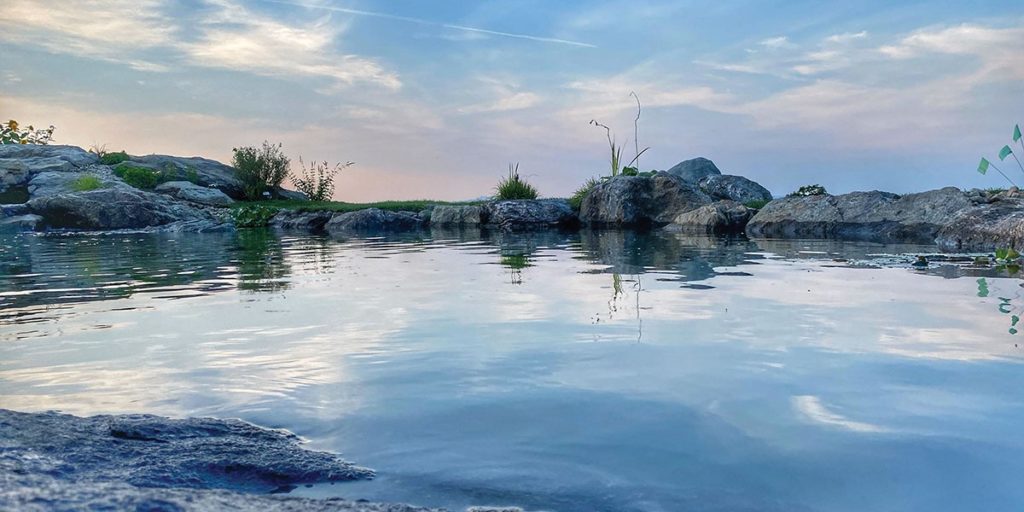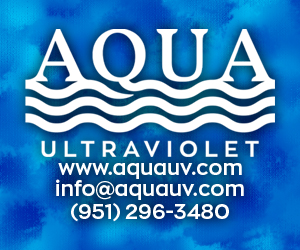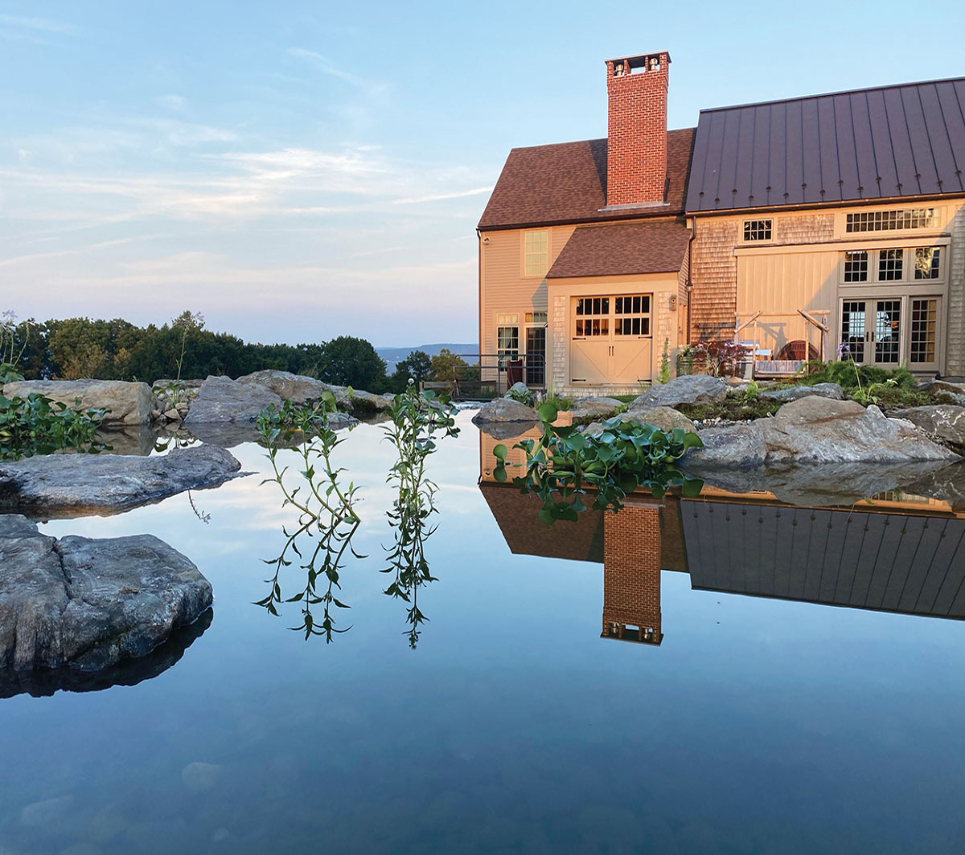
There is a moment when a dry, dusty rock is struck by water and comes alive. It’s this moment that I live for as a pond builder. Watching my clients’ faces as they experience this phenomenon for the first time is beyond any monetary gain that could be had from any project.
Know Your Customer

A pond construction project is a dream. (After all, no one actually needs a pond!) Getting to know the customers, their dreams and their intended uses of the pond is paramount to success. Are there children, dogs or those with disabilities who need to access the water? How does the family imagine using the space? What are the viewpoints and areas for access?
I love it when customers send me a picture that explains what they are looking for. One client sent me a picture of a family and a fire by a pond the day before the project started. The photo demonstrated the value this customer placed on the spaces where he and his family could interact with the pond together.
Only after we understand a homeowner’s dream, we begin to think of the practical. What is the slope? What utilities and other obstacles are known to be there?
Design Process

Then, I sketch. Everyone has a different process, but for me, getting the ideas together in a sketch helps me think through the potential challenges of the job and formulate a process for the build. I look for lines through the landscape as if it were a painting. If there is a natural slope, I want to tie into that. I want one rock to lead naturally to another like a chunk was just taken out from between the two by some great storm. I like to set nice big boulders on outside curves to really accentuate the shape of the pond and narrower stone to hug the inside corners.
Everyone sees and sets stone differently. I have had the opportunity to work with many people in the pond industry, and it is amazing how many different ways people can see a rock. I prefer to use a rock as it is, without building it up or spending a lot of time cutting it. I generally like them to be linear opposed to being set upright — although there is a time and place for all that, too.
I am known for my edge details, but to me, the best edges are planned at the beginning of the project so that they disappear into the pond and are rugged even in heavily used areas. I like the rock work to mimic the natural ledges we have in abundance around New England, so we make certain that the bottoms of the rock are buried or hidden by another rock.
When I’m finished sketching and visualizing the final product, I come up with a materials estimate and begin the job costing.
Laying the Landscape
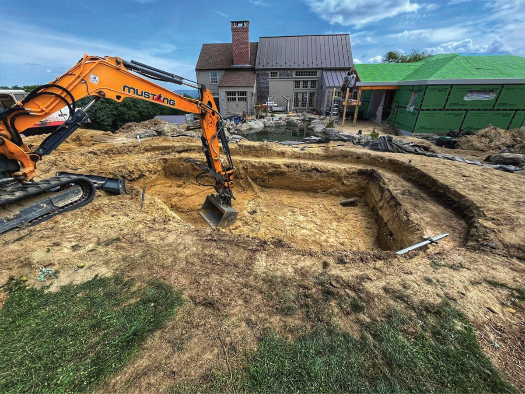
Our natural native New Hampshire waterfalls are generally ledge or very large boulders. Over time, these rock outcroppings are carved out of the mountains themselves. To mimic this the rock work under the water, we began the ledge for the waterfall at the bottom of the pond. We cut in shelves to build the stone outcropping over, and we placed the stone in such a way as to not have a traditional ring of stone around each level. Some stone came up two or more levels. We utilized more cobble and stone in the shelves to continue the look of a ledge. A few spaces were left with just a gravel mix across the shelf to leave room for aquatics.
By being efficient and utilizing the same excavation, plumbing and mechanics systems for every pond, we gain valuable time to invest in the waterfalls and other interactive spaces. Unless it is just not possible, we start our excavation and level the grade around the entire pond or basin. This makes setting stone straightforward and leaves nothing to the imagination. It also helps us avoid low sections of edging that will need to be built back up at the end of a project. We generally work with 3 inches of freeboard, which is the space between the top of the water and the top edge of the pond liner. If we have lots of green pond builders working with us, we might increase that amount to 5 inches.
“I like the rock work to mimic the natural ledges we have in abundance around New England, so we make certain that the bottoms of the rock are buried or hidden by another rock.”
April Dugan
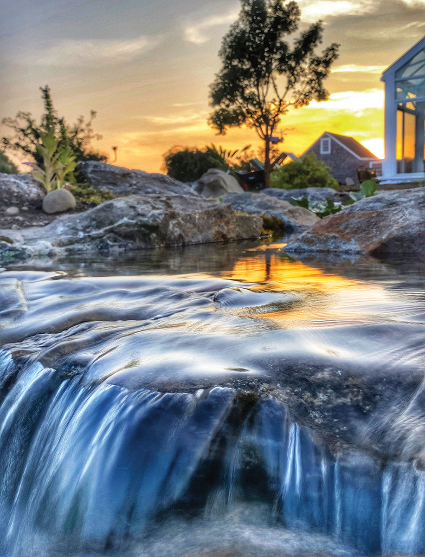
One of the best parts of a pond build is watching how people interact with the finished space, especially when they are drawn to use elements like sitting and stepping stones, islands and thresholds the way they were intended. In areas where people will be interacting, feeding fish, crossing or accessing the water, I like to incorporate a threshold stone — a big, solid rock with a surface that is easy to walk on. On this project, two entire edges of the patio abutted the pond, making most of the pond highly interactive. We used six 10-foot stones that were flat and sloping into the edge of the water. It allowed for the edge to remain really low profile, incredibly accessible and stable.
In Japanese gardening, they often invite the larger landscape into the garden. I feel that this pond accomplishes that. By staying low profile, the water very nearly touches the sky and mountain ranges beyond the project. On days when the wind is still, the reflective view is stunning. One can easily get lost in the beauty of the sky and water here.
Icing on the Cake
The icing on the cake is always the aquatic plantings that blend terrestrial gardens into the water. In this pond we used lotus, lily, pickerel reed, marsh marigolds and water hyacinths, to name just a few. We are generous with the application of moss to our projects, which helps lend a sense of permanency. The homeowners were quick to install sod and some stunning terrestrial gardens that complemented the whole project superbly.
For this project, we had an exceptional group of highly talented artists. Each person on the team was selected for a particular skill set they brought that would complement the whole team. I am so grateful for each and every one of them.
When we step away from any project, we want it to look as though it’s been there for many, many years — and be sturdy enough to be there for many more to come.
